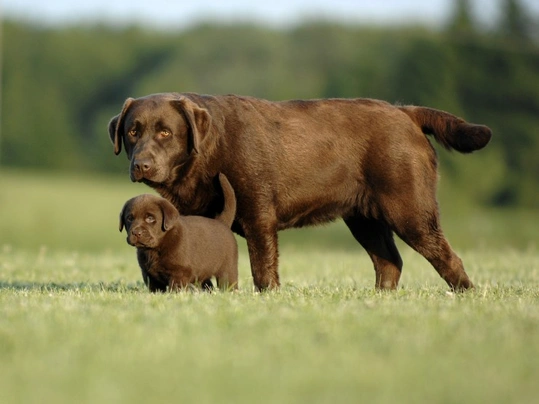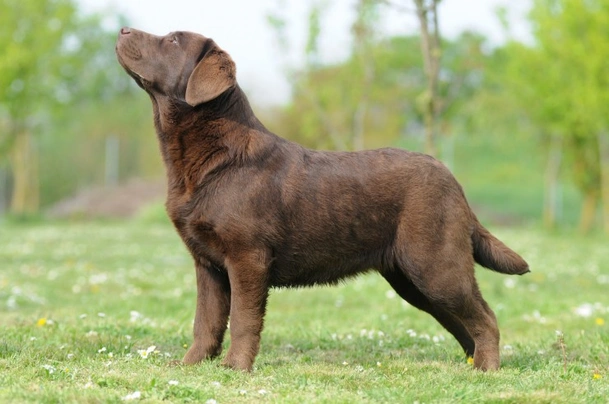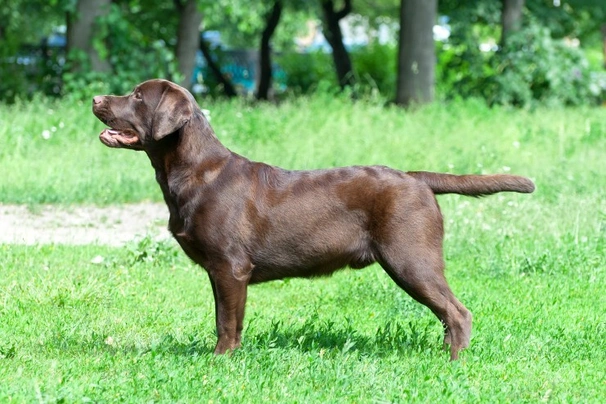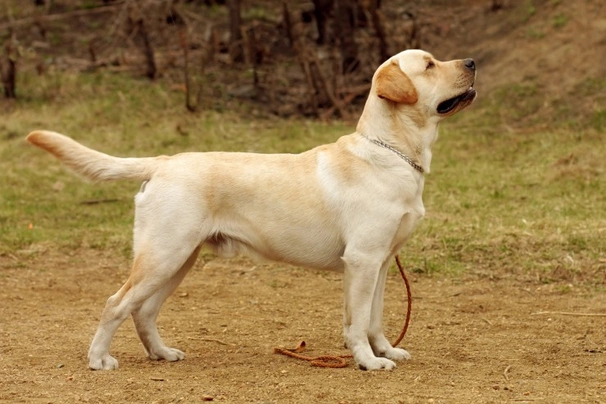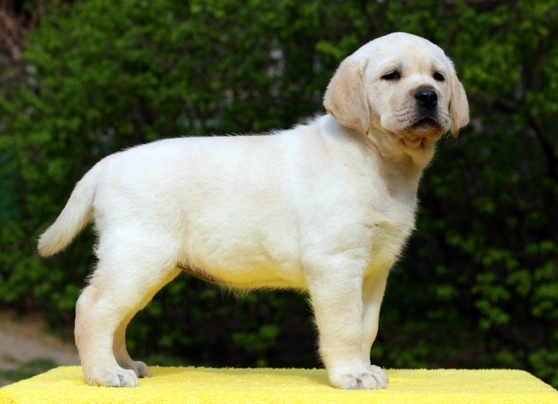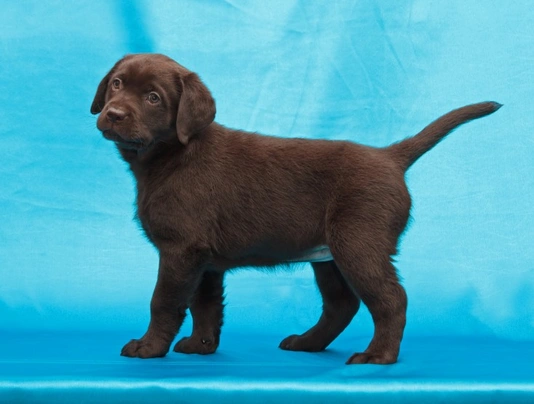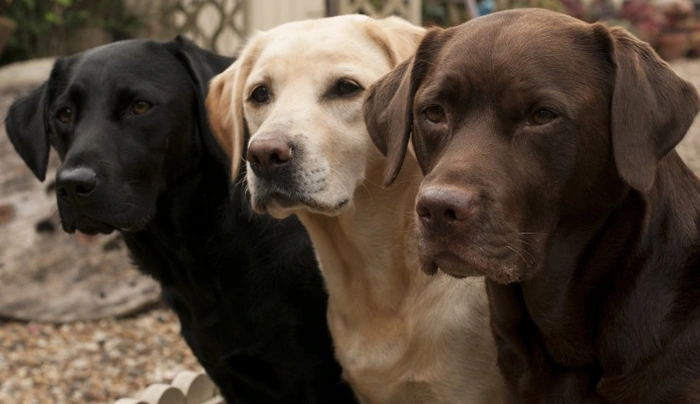Labrador Retriever
Pros
Cons
Introduction of the Labrador Retriever
Labrador Retrievers have consistently been one of the most popular family pets both in the UK and elsewhere in the world for decades thanks to trustworthy and proven natures. Labs are gentle yet outgoing and always eager to please which in short makes them highly trainable. Being so intelligent the Labrador Retriever thrives just as well in a home environment as they do working alongside their owners in the field.
Originally bred to retrieve nets for fishermen and then game and fowl for hunters the Labrador Retriever excels when asked to work in difficult and challenging terrains. They are more especially suited to work in and around water thanks to their alertness and excellent water-resistant coats. The Labrador Retriever loves taking part in canine sports and they excel at other activities which includes working as Guide and Assistant Dogs. For decades the Labrador Retriever has consistently been at the top of the list as a preferred companion and family pet throughout the world.
History of the Labrador Retriever
The Labrador Retriever as the name suggests was originally bred for a specific purpose which was to retrieve nets for fishermen and the fact they have webbed paws makes them extremely strong and able swimmers. The breed was later used to retrieve game when birds were flushed out and shot by hunters which often took place in challenging environments which included watery marshlands.
The breed originates from the coastal regions of Newfoundland and is thought to have been created by crossing St John's Water Dogs with other smaller breeds of water dogs and possibly Mastiffs a breed introduced to the country by Portuguese fishermen in the 16th and 17th centuries. The St John's Water dog is also an ancestor of the Newfoundland a dog that is closely related to the Labrador with the Lab being the smaller of the two dogs and having shorter coats whereas the Newfoundland is the larger dog and one that was used to haul carts back in the day.
Labradors were first introduced into the UK in the late 1800's by the Earl of Malmsbury and Col Peter Hawker. Both men developed a keen interest in the breed and arranged for a selection of dogs to be imported to the UK. Many Chocolate Labradors are decendants of a Labrador Retriever called Buccleuch Avon a dog that was gifted to the Duke of Buccleuch in Scotland in 1890 by the Duke of Malmsbury. Another dog called Malmesbury Tramp owned by Countess Howe is among the main ancestors of the modern Labrador Retrievers we see today.
Breed numbers fell in Newfoundland for a combination of reasons but thanks to the efforts of the first and second Earls of Malmesbury who through their careful breeding programmes continued to develop and improve the breed in the UK where they were to become some of the most highly prized as gundogs in the field.
Today the Labrador Retriever remains the fourth most popular breed in the UK and for good reason they are reliable trustworthy and incredibly loyal making them the perfect family pet and companion to share a home with and they are notably extremely good when they are around children.
Interesting facts about the breed
- Are Labrador Retrievers a vulnerable breed? No they are among the most popular both in the UK and in other countries of the world
- There is some thought that Labrador Retrievers might have been called St. John's dogs or they may have been called Lesser Newfoundlands. Other people think the breed was named after the Portuguese word "lavradores" or the Spanish word "labradores" which when translated means rural/agricultural workers. There is a village in Portugal called Castro Laboreiro where herding dogs are very similar looking to Labrador Retrievers too
- Liver and golden Labs were known to exist way back in 1807 when they were referred to a chocolate or butterscotch-yellow coloured dogs
- The first yellow Labrador to have been recognised was a dog named Ben of Hyde
- Chocolate Labs became popular in the thirties
- Gold and fox red Labradors were bred to reestablish the colours by breeders in England using Balrion King Frost and his grandson Wynfaul Tabasco a dog responsible for being the biggest influence in re-establishing the colour fox red in the breed
- All chocolate Labradors can trace their origins to eight bloodlines
Appearance of the Labrador Retriever
Height at the withers: Males 56 - 61 cm Females 56 - 61 cm
Average Weight: Males 29 - 36 kg Females 25 - 32 kg
The Labrador Retriever is a strongly built medium to large size dog that is broad and deep through the chest and ribs. They possess strong and compact webbed feet which are perfect for the hours Labrador Retrievers generally enjoy spending in water and marshlands. Their coats are thick dense and extremely water-resistant perfect for the environments they were bred to work in and they boast otter-like tails.
The Labrador Retriever's coat is short and unlike a Golden Retriever has no feathering at all while the tail a defining characteristic of the breed is powerful and rudder-like being thick at the base before tapering away at the tip. Labradors are primarily a solid yellow black or liver/chocolate in colour. However the yellow variety ranges from a light cream to a red 'fox' colour sometimes displaying a white spot in the chest area.
Eyes are usually brown or hazel and medium in size with most breeders claiming they express an even temper and intelligence the breed is renowned for. Ears are pendant shaped and while not too large or heavy they hang neatly and close to a dog's head. A Labrador's nose can vary in colour according to coat colour with yellow dogs typically displaying a black nose and a Chocolate Labrador having a lighter brown one. However it is not uncommon for nose colours of any Labrador to fade as dogs mature and this is not considered a fault in the show ring.
Their wide muzzle contains a set of strong teeth with a bite which should meet with scissor-like precision enabling a 'soft mouth' in the field capable of holding game firmly yet gently without causing any damage to any animals or birds they are sent to retrieve.
When it comes to their coat and colours Labrador Retrievers can be the following which are all accepted breed colours under the Kennel Club breed standard:
- Solid black
- Solid yellow
- Solid liver/chocolate
It is worth noting that the shade of a yellow Lab's coat can be light cream to a deeper red fox. Labrador Retrievers often have a white spot on their chests which is allowed under the Kennel Club breed standard.
Gait/movement
Labrador Retrievers have a free moving gait and they cover a good amount of ground. When they move it is always straight and true both in their forequarters and their hind quarters.
Faults
Dogs that display any departure from the accepted Kennel Club breed standard would be thought of as a fault and depending of the seriousness of the fault could be considered as being detrimental to a Lab's well-being and health as well as their ability to work.
Male Labrador Retrievers should have two normal testicles that are fully descended into their scrotums.
It is worth noting that the size of a Labrador Retrievers as described by the Kennel Club are to be used as guidelines only and that Labs can be smaller or larger they can also weigh a little more or a little less than stated in their breed standard which is to be used as a guideline only.
Temperament of the Labrador Retriever
Labradors are famous for their easy going yet playful and intelligent natures typically displaying a temperament that is equally at home in the field in the show ring or in a home environment or as an assistance dog. Rarely displaying aggression this ease of nature makes them unsurpassable not only as pets but also as assistance and working dogs. They thrive in a home environment where they receive plenty of attention training exercise and mental stimulation. They also benefit from knowing their place in the "pack" and looking up to their owners as the alpha dog and for leadership.
Labrador Retrievers need quite a bit of care and attention but they are one of the best choices for first-time dog owners because of their affectionate and loyal natures. However as mentioned above they like to know who is "boss" and are much happier when they can look to their owners for direction.
They also enjoy playing interactive games which keeps them mentally stimulated and reduces the risks of any boredom related unwanted behaviours from developing. Lighter weight types of this lovely breed also do very well at canine sporting activities like agilityandFlyball. The great thing about Labs is they just love to please and will do their level best to get things right not only because of the reward they might get but because they enjoy pleasing the people they love so much.
Labrador Retrievers are generally very good around strangers and people they don't know which is all part of their "friendly" and approachable nature. They are also very adaptable characters and will settle quickly once they have been well exercised in most environments they find themselves in. It is possible to keep a Lab in an apartment providing they are given plenty of daily exercise and not left cooped up for great lengths of time which could result in boredom setting in as well as a few unwanted behavioural issues.
Are they a good choice for first time owners?
Over the years and through careful and selective breeding Labrador Retrievers have proved themselves to be trustworthy and reliable dogs both in the field and in a home environment which in short means they are the perfect pet for first time dog owners.
What about prey drive?
When it comes to prey drive it would be better to break this down to include a few more of the breed's "drives" than just “prey”. In all dogs drives can be strong and in Labs which includes things like food drive social drive and many more. Dogs are born with specific "instincts" which they don't have to be taught. Drives on the other hand relate to "motivation" rather than the ability to do something.
Where Labrador Retrievers are concerned it is a good idea to understand their natural instincts and their various drives because it helps better understand a dog and will also provide valuable information about the breed when it comes to training which is especially true when it comes to "unwanted" behaviours. With this said a Lab might display some instincts or natural behaviours that are a bit anti-social which includes when dogs smell another dog's bum or when they find some interesting poo to sniff at which are just two things dogs like to do and which is all part of their natural makeup but it would be best not to try to change these behaviours in the interest of the dog. Some of the various "drives" seen in Labrador Retrievers are as follows:
Pack Drive
Labs are known to have a high pack drive and as a result they are social dogs by nature which translated to a home environment means they are never being happier than when they get to spend time with their families. This is one of the reasons why Labs are so very people-oriented. Having a high pack drive also means that Labs are easy to train because they like to "please" and thoroughly enjoy all the attention they get when they are being trained. They respond especially well to praise which makes positive reinforcement training all the easier. The downside to a dog having a high pack drive is that they are more at risk of suffering from separation anxiety when left on their own.
Food drive
Labs also have an extremely high food drive even though they are regularly fed they still instinctively feel the need to eat and therefore to "survive". Having a high food drive is one of the reasons why Labs are easy to train especially when there is a high value food reward at the end of a training session. The downside to them having a very high food drive is that Labs can all too easily put on far too much weight which can seriously impact a dog's overall health and wellbeing. An obese Lab would enjoy a much shorter life span too.
Retrieve drive
Labs are renowned for having an extremely high retrieve drive which is why they have always been so highly prized by hunters as gundogs in the field. In the home environment it’s why a Labrador loves to play interactive games where they are asked to retrieve things that owners and other people throw for them which often sees a person getting tired out well before a Lab would ever do.
Play drive
Labradors are playful by nature and more especially when they are well socialised from a young age. In fact a well socialised Lab retains their playful natures well into their senior years. Labs take a long time to "grow up" which is usually when they are around 3 years old and in some dogs this can be even later.
Defence drive
Defence drive in any dog is their need to respond to anything they find threatening. A dog's instinct in a situation they find dangerous is to fight or flee. A well socialised and happy Lab will defend their territory and their families if the need arises but much less so than many other breeds. With this said if a Lab finds themselves cornered in a stressfull and threatening situation they will do their best to "flee" rather than "fight" but it always best to avoid putting any dog in this kind of situation and to recognise when a pet might be feeling threatened and take the necessary steps to resolve the situation.
Territorial drive
A well-trained Labrador will protect his territory home and family by barking when anything happens that they find worrying. However they will not bark every time someone comes to the door or when a door-bell rings. Any type of behaviour like this can be gently curbed when a Lab is still young so they grow into well rounded happy and confident adult dogs.
Guard drive
Labrador Retrievers are known to have this trait in them but the good news is that with gentle training the guard drive can be curbed so that a dog does not feel the need to guard their resources which includes food toys the kids and anything else a Lab might not want to share.
Herding drive
Labs are not known to have a strong herding drive and therefore it is not generally something an owner need worry about when sharing a home with a Labrador Retriever.
Hunting drive
Labradors have a high hunting drive which is a trait that's deeply embedded in their psyche. They have an incredible sense of smell which enables them to track down prey or anything else which includes a favourite treat that an owner has hidden away. Sharing a home with a Lab means satisfying their urge to hunt which can be done by interactive play and by hiding favourite toys around the home for a dog to find which is a game that Labs thoroughly enjoy.
Finally prey drive
Labrador Retrievers do have a strong prey drive but the good news is that through careful and early training this can be gently curbed so it is redirected in a positive way by playing safe and fun interactive games with them.
What about playfulness?
As previously mentioned Labs mature slowly and therefore they retain their puppy playfulness that much longer than many other breeds. They only fully mature when they are 3 years old but they remain very playful right into their senior years.
What about adaptability?
Labrador Retrievers are highly adaptable dogs by nature although they are better suited to living in a house rather than an apartment because they enjoy being in the great outdoors so much.
What about separation anxiety?
Labs form extremely strong bonds with their owners and families. As such they do not like finding themselves on their own for too long and will suffer separation anxiety if they do. Anyone wanting to share a home with a Lab and who knows they will spend quite a bit of time out of the house when they are working would need to train their canine companions that being alone is alright and not a stressful situation to avoid them suffering from separation anxiety.
What about excessive barking?
Labs are not known to be "barkers" and typically only bark in certain situations which includes when they are at play.
Do Labrador Retrievers like water?
Labrador Retrievers have a real affinity with water and will jump in whenever they get the chance. As such extra care must be taken when they are walked anywhere near more dangerous water courses just in case they decide to leap in.
Do Labs make good watchdogs?
Labradors are not the best choice when it comes to being a watchdog because they are so people-friendly. A Lab would bark however if they feel their homes or families are being threatened in any way.
When should Labrador Retrievers be spayed or neutered?
A female Lab should be spayed when she is 6 months old and not beforehand. There are certain risks when female dogs are spayed at an early age. Male dogs too should be neutered when they are 6 months old and not beforehand because both testicles need to have fully descended before the surgery can be carried out.
Intelligence / Trainability of the Labrador Retriever
Labrador Retrievers are renowned for their kind and willing natures which in short means they are relatively easy to train which is why they are such a popular choice of working gundog. They excel at many canine sports and this includes obedience competitions. They are renowned guide dogs as well as hearing dogs with the added bonus being that Labrador Retrievers genuinely enjoy taking part in this type of activity.
Labs love to please they thrive on being praised and because they boast having such a high "food drive" using high value rewards makes their training that much easier. However because Labs are so prone to putting on weight far too easily it is best to keep food rewards to a minimum. They respond extremely well to positive reinforcement training but do not answer well to any sort of harsh correction of heavier handed treatment which could have an adverse effect on a dog’s confidence and nature.
Children and other
The vast majority of Labradors instinctively enjoy the company of children and being in a family environment. They are tremendously loyal loving and trustworthy dogs that make for consistently dependable companions and family pets. If well socialised from a young age as puppies they get on with people of all ages and other animals. They are considered one of the best disposed and affable of dogs on the planet which is just one of the reasons why they always figure high on the list of best family pet not only in the UK but elsewhere in the world too.
Health of the Labrador Retriever
The average life expectancy of a Labrador is 10 - 12 years when properly cared for and fed an appropriate good quality diet to suit their ages.
Most Labradors are known to have hearty appetites and will overeat if an owner allows them to. Because of this a dog may become overweight or obese all too easily a dilemma that can affect their overall health and shorten their life span considerably. Obesity can lead to joint problems due to the additional weight a dog carries and all sorts of heart problems.
Labradors are prone to inheriting several forms of eye disorder which includes the following:
- Hereditary Cataracts (HD) - clinical eye test can be carried out at 12 months and older
- Multifocal Retinal Dysplasia (MRD) - clinical eye test can be carried out at 12 months and older - puppies can be tested at 7 weeks
- Total Retinal Dysplasia (TRD) - clinical eye test can be carried out at 12 months and older
- Central Progressive Retinal Atrophy (CPRA) - clinical eye test can be carried out at 12 months and older
- General Progressive Retinal Atrophy (GPRA) - clinical eye test can be carried out at 12 months and older - tests need to be done annually thereafter
- General Progressive Retinal Atrophy (GPRA) - DNA test - can be carried out at any age
Other inherited disorders include the following:
- Hip Dysplasia (HD) - X-rays can be carried out at 12 months and older to establish a hip score - the lower the score the better
- Elbow Dysplasia (ED) - X-rays can be carried out at 12 months and older to establish a score - the lower the score the better
- Centronuclear Myopathy (CNM) - DNA test can be carried out at any age
- Exercise Induced Collapse (EIC) - DNA test can be carried out at any age
What about obesity problems?
As previously touched upon Labs have a high food drive and as such if a dog is overfed given too many treats and not given enough daily exercise they are at great risk of putting on too much weight which ends up with a dog being obese. An obese Lab's well-being will suffer dramatically and it would shorten their lifespans by several years. Carrying too much weight puts a Lab at greater risk of developing heart issues and because a dog would be reluctant to go out on walks getting them back into shape can prove challenging.
What about allergies?
Unfortunately Labs like many other breeds today are prone to suffering from food allergies. The problems can start when dogs are any age and when it occurs when a dog is older it could be triggered by certain foods they have been eating all their lives without ever having had a problem. Most Labs that suffer from food allergies start to scratch at their ears and skin in certain areas of their bodies which just makes their condition that much worse. They constantly lick and chew at an affected area which they do to relieve the itchiness they are experiencing.
Quite a few Labs can also develop chronic ear problems as a result of yeast infections and even when treated the problem soon recurs. Any sort of food allergy can prove challenging to diagnose because identifying the triggers takes time because it is typically a process of elimination. With this said a Lab might develop an allergy to something other than food. The trigger could well be pollen or some other environmental problem that disagrees with them. Keeping a diary of when a Lab seems to suffer an allergic reaction will help a vet when it comes to identifying the triggers but owners need to be prepared for a long haul when it comes to resolving an allergy once it flares up.
Recognising health issues in Labrador Retrievers
Because Labs are known to suffer from quite a few hereditary congenital and acquired health issues it is very important for owners to keep a close eye on their pet's health. Recognising when there may be a problem early means a condition can be treated sooner rather than later and this often makes a disorder that much easier to treat with the prognosis being better too.
Participating in health schemes
There are many breed specific health schemes that have been set up over the years which owners and breeders are advised to take part in. The schemes that are available for Labrador Retrievers are as follows:
- Hereditary Cataracts (HD) - clinical eye test can be carried out at 12 months and older
- Multifocal Retinal Dysplasia (MRD) - clinical eye test can be carried out at 12 months and older - puppies can be tested at 7 weeks
- Total Retinal Dysplasia (TRD) - clinical eye test can be carried out at 12 months and older
- Central Progressive Retinal Atrophy (CPRA) - clinical eye test can be carried out at 12 months and older
- General Progressive Retinal Atrophy (GPRA) - clinical eye test can be carried out at 12 months and older - tests need to be done annually thereafter
- General Progressive Retinal Atrophy (GPRA) - DNA test - can be carried out at any age
- Hip Dysplasia (HD) - X-rays can be carried out at 12 months and older to establish a hip score - the lower the score the better
- Elbow Dysplasia (ED) - X-rays can be carried out at 12 months and older to establish a score - the lower the score the better
- Centronuclear Myopathy (CNM) - DNA test can be carried out at any age
- Exercise Induced Collapse (EIC) - DNA test can be carried out at any age
Potential owners can check health results of a Labrador puppy or adult dog on the Kennel Club website through their Health Test Results Finder.
What about breed specific breeding restrictions?
There are breed specific breeding restrictions for Labrador Retrievers which are as follows:
The Kennel Club only accepts registering yellow Lab puppies when both parent dogs are yellow because it is only genetic possible for two yellow Labrador Retrievers to produce yellow puppies
The Kennel Club only accepts registering chocolate (liver) or yellow Lab puppies when both parent dogs are chocolate (liver) coloured because it is only genetically possible for them to be produced through this mating.
What about Assured Breeder Requirements?
Assured Breeders are required to use the following schemes and tests and it is mandatory for them to do so:
- BVA/KC Hip Dysplasia Scheme
- Eye testing
Kennel Club Assured Breeders as well as other breeders are also advised to use the following schemes:
- BVA/KC Elbow Dysplasia Scheme
- DNA test - prcd-PRA
- DNA test - CNM
- DNA test - EIC
- DNA test - SD2
- DNA test - HNPK
More information on breed specific health tests and test results for the Labrador Retriever can be found on the Kennel Club website and on Breed Club sites.
Caring for the Labrador Retriever
As with any other breed Labrador Retrievers need to be groomed on a regular basis to make sure their coats and skin are kept in tip-top condition. They benefit from being professionally groomed at least 3 times a year so their coats can be hand-stripped which makes keeping on top of things that much easier. They also need to be given regular daily exercise to make sure they remain fit and healthy. On top of this Labrador Retrievers need to be fed good quality diet throughout their lives to ensure all their nutritional needs are met.
Caring for a Labrador Retriever puppy
A breeder should always give a new owner a sheet detailing how much a puppy has been fed the type of food they have been given and how often a puppy has been fed in a 24-hour period. It is important for new owners to stick to this routine to avoid any digestive issues developing. The breeder should also have given a new owner all the relevant documentation for a puppy which must to include their worming programme and details of when a puppy was microchipped.
Once a puppy arrives in a new home it is important to keep worming them on a regular basis and the schedule needs to be as follows:
- Puppies should be wormed at 6 months old
- They need to be wormed again when they are 8 months old
- Puppies should be wormed when they are 10 months old
- They need to be wormed when they are 12 months old
Lab puppies are great fun to have around because they are so playful when they are awake that is. All puppies play hard but they need to take lots of naps in between bouts of playtime. Labradors as previously mentioned thrive in a home environment and tend to settle well into family life although the first few days can prove a little anxious for them having just left their mothers and their litter mates. As such it's important to time when a puppy is introduced to their new homes making sure that someone will be there to keep them company until they feel more settled.
New owners should set up a nice safe quiet area where puppy can retreat to for their naps. A nice quiet corner that's not too out of the way is the ideal because it's important for puppy to know that someone is around and owners should be able to hear a puppy and be able to keep an eye on them from a distance. In short the area should be away from a lot of traffic without being totally isolated.
Things you'll need for your new puppy
Needless to say there are certain items that new owners need to already have in the home prior to bringing a new puppy home. It's often a good idea to restrict how much space a puppy plays in more especially when you can't keep an eye on what they get up to bearing in mind that puppies are often quite boisterous which means investing in puppy gates or a large enough playpen that allows a Lab puppy the room to express themselves while keeping them safe too. The items needed are therefore as follows:
- Good quality puppy or baby gates to fit on doors
- A good well-made playpen that's large enough for a Lab puppy to play in so they can really express themselves as puppies like to do
- Lots of well-made toys which must include good quality chews suitable for puppies to gnaw on bearing in mind that a puppy will start teething anything from when they are 3 to 8 months old
- Good quality feed and water bowls which ideally should be ceramic rather than plastic or metal
- A grooming glove
- A slicker brush or soft bristle brush
- Dog specific toothpaste and a toothbrush
- Scissors with rounded ends
- Nail clippers
- Puppy shampoo and conditioner which must be specifically formulated for use on dogs
- A well-made dog collar or harness
- A couple of strong dog leads
- A well-made dog bed that's not too small or too big
- A well-made dog crate for use in the car and in the home that's large enough for a Lab puppy to move around in
- Baby blankets to put in your Lab's crate and in their beds for when they want to nap or go to sleep at night
Keeping the noise down
All puppies are sensitive to noise including Lab puppies. It's important to keep the noise levels down when a new puppy arrives in the home. TVs and music should not be played too loud which could end up stressing a small puppy out.
Keeping vet appointments
It's very important to keep veterinary appointments so that a Lab puppy can be given all their vaccinations and taking them to the surgery when young gets them used to all those strange smells that can unnerve many dogs.
What about older Labrador Retriever when they reach their senior years?
Older Labs need lots of special care because as they reach their golden years they are more at risk of developing certain health concerns. Physically a Lab will start to have a greying muzzle but there will be other noticeable changes too which includes the following:
- Coats become coarser
- A loss of muscle tone
- Labs can either become overweight or underweight
- They have reduced strength and stamina
- Older Labs have difficulty regulating their body temperature
- They often develop arthritis
- Immune systems do not work as efficiently as they once did which means older Labs are more susceptible to infections
Older Labrador Retrievers change mentally too which means their response time tends to be slower as such they develop the following:
- They respond less to external stimuli due to impaired vision or hearing
- They tend to be a little pickier about their food
- They have a lower pain threshold
- Become intolerant of any change
- Often an older Lab can feel disorientated
Living with a Lab in their golden years means taking on a few more responsibilities but these are easily managed and should include taking a look at their diet the amount of exercise they are given how often their dog beds need changing and keeping an eye on the condition of their teeth.
Older Labs need to be fed a good quality diet that meets their needs at this stage of their lives all the while keeping a close eye on a dog's weight. A rough feeding guide for older Labradors is as follows bearing in mind they should be fed highly digestible food that does not contain any additives:
- Protein content should be anything from 14 – 21%
- Fat content should be less than 10%
- Fibre content should be less than 4%
- Calcium content should be 0.5 – 0.8%
- Phosphorous content should be 0.4 – 0.7%
- Sodium content should be 0.2 – 0.4%
Older Labs don't need to be given the same amount of daily exercise as a younger dog but they still need the right amount of physical activity to maintain muscle tone and to prevent a dog from putting on too much weight. All dogs need access to fresh clean water and this is especially true of older dogs when they reach their golden years because they are more at risk of developing kidney disorders.
Grooming of the Labrador Retriever
Having short dense coats Labrador Retrievers need to be groomed on a weekly basis for their coats and skin to remain in good condition and to keep shedding under control. This is especially true during the Spring and the Autumn when they tend to shed the most. These dogs also benefit for being regularly bathed during the warmer summer months being careful not to over-do things. It's also essential to use dog-specific shampoos when bathing a dog otherwise it would lead to upsetting the pH balance in a dog's skin which can lead to them developing painful skin irritations and allergies.
Ideal grooming routine
Interestingly black Labs tend to shed more hair in the spring and the autumn whereas their yellow counterparts shed copious amounts of hair throughout the year and when they blow their coats they really do so quite dramatically. The tools needed for grooming a Lab are as follows:
- A wire slicker brush
- A short-haired rake
- A narrow-toothed comb
- A wide toothed comb
- Nail clippers
- A bristle brush
Labrador Retrievers should never be shaved or clipped unless they are about to undergo some form of surgery or when they have developed a hotspot that needs treating.
The rule of thumb when grooming a Lab is to brush a dead coat out in the spring and then again in the autumn which allows their new coats to grow through that much faster. The best way to do this is to bath a Lab using a dog specific shampoo and to thoroughly blow dry them afterwards before carefully running a slicker brush the coat. This will remove any dead and loose hair from a Lab's coat so that their new coats can easily grow through with the added advantage being that it keeps a dog's shed hair off the furniture and elsewhere around the home and car.
Exercise of the Labrador Retriever
Labrador Retrievers are high energy dogs that need to be given the right amount of daily exercise to remain healthy and fit. Ideally this should be a minimum of 2 hours a day and more if possible. A Lab's daily exercise routine should include plenty of mental stimulation because without this a dog might quickly pick up some unwanted behaviours. If not given enough exercise Labs get bored and are more at risk of putting on weight which negatively impacts their well-being.
Labs do a lot better if their exercise includes other things apart from just walking more especially if they are in the prime of life and don't suffer from any health issues. Being high energy and intelligent Labs benefit from being taught to retrieve which is already in their blood. This means owners can let their dogs off their leads in a park or other safe place and throw items for their Labs to retrieve which they thoroughly enjoy.
Labs also like to express themselves by interacting with other dogs because they are incredibly social by nature especially when well socialised. Letting a Lab run free in a safe environment where there are other dogs provides a ton of mental stimulation as well as exercise. Just letting a Lab into a back garden would not be enough to keep a dog satisfied even if the space is large. Dogs like meeting other dogs so they can interact which is important for Labrador Retrievers.
The other thing to bear in mind is that Labs adore swimming and should be allowed to do so whenever possible but only in safe environments. Care should always be taken when walking a Lab anywhere near more dangerous water courses just in case they decide to jump in.
Feeding of the Labrador Retriever
Labradors are known to like their food and are prone to putting on weight if fed the incorrect amount to suit their ages and the amount of daily exercise they are given. As such owners should carefully monitor their dog's weight and to limit the number of treats they are given during any training sessions. Labradors are not fussy eaters but they do need to be fed a good quality diet that's rich in all the right nutrients throughout their lives from puppyhood to their golden years.
Feeding guide for Labrador Retriever puppies
Once a Lab puppy is settled into their new homes which would normally take a few days it is possible to start thinking about changing their diets but this should only be done gradually over the course of 4 weeks. An ideal daily feeding guide for a Lab puppy that suits the first few months of their lives is as follows:
- 2 months old - 211 g to 237 g depending on a puppy's build
- 3 months old - 262 g to 308 g depending on a puppy's build
- 4 months old - 283 g to 339 g depending on a puppy's build
- 6 months old - 323 g to 445 g depending on a puppy's build
- 8 months old - 299 g to 418 g depending on a puppy's build
- 10 months old - 286 g to 411 g depending on a puppy's build
- 12 months old - 287 g to 401 g depending on a puppy's build
- 14 months old - 285 g to 394 g depending on a puppy's build
Feeding an adult Labrador Retriever
As a rough guideline an adult Labrador Retriever should be fed the following amounts on a daily basis making sure a dog is given the right amount of daily exercise and that food rewards are kept to a minimum:
- 400 - 560 g good quality highly nutritious food a day
Labrador Retriever price
If you are looking to buy a Labrador Retriever you would need to be prepared to pay anything from £350 to well over £1000 for a well-bred pedigree puppy. As a rough guide the cost of insuring a male 3-year old Labrador Retriever in northern England could be as little as £22.62 for basic cover to just over £48.38 a month for a lifetime policy (quote as of August 2017). It's worth noting that lots of things are factored into a dog's insurance premium and this includes where you live in the UK and a dog's age.
When it comes to food costs you would need to buy the best quality dog food whether wet or dry for your dog throughout their lives and to suit the different stages of their lives. This would set you back between £40-£50 per month. On top of this you would need to factor in veterinary costs if you want to share your home with a Lab and this includes their initial vaccinations neutering or spaying your dog when the time is right and then their annual health check visits all of which quickly adds up to over a £1000 a year.
As a rough guide the average cost to keep and care for a Lab would be in the region of £80 - £100 a month depending on the level of insurance cover you opt to buy but this does not include the initial cost of buying a well-bred pedigree Labrador Retriever puppy.
Buying advice
When visiting and buying any puppy or dog there are many important things to consider and questions to ask of the breeder/seller. You can read our generic puppy/dog advice here which includes making sure you see the puppy with its mother and to verify that the dog has been wormed and microchipped.
When buying a Labrador Retriever the size of a dog as stated by the Kennel Club Breed Standard is only a guide and is given as being the ideal for the breed. As such a Lab could be smaller or larger and may weigh slightly more or less than the given size in their breed standard.
With Labs there is specific advice questions and protocols to follow when buying a puppy which are as follows:
- Potential buyers should be aware that the Kennel Club frowns upon Labs with legs that are too short in proportion to the depth of a dog's body and to the length of their backs
- Many well-established Labrador Retriever breed clubs warn potential buyers of scams where adverts show images of beautiful Labrador Retriever puppies for sale. However these sellers ask buyers for money up front before they agree to delivering a puppy to a new home. Potential buyers should never buy a Labrador Retriever puppy unseen and should never pay a deposit to a seller before collecting a puppy from them
- Labrador Retrievers are among the most popular breeds in the UK and therefore puppies can command a lot of money. As such there are many amateur breeders/people who breed Labrador Retrievers far too often so they can make a quick profit without caring for the welfare of the puppies their dam or the breed in general. Under Kennel Club rules a dam can only produce 4 litters and she has to be between a certain age to do so. As such anyone wishing to buy a Labrador Retriever puppy should think very carefully about who they purchase their puppy from and should always ask to see the relevant paperwork pertaining to a Lab's lineage their vaccinations and their microchipping
